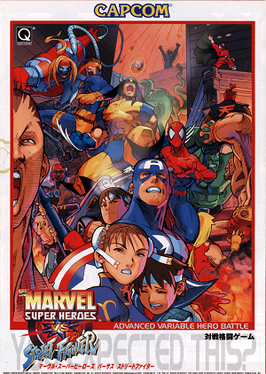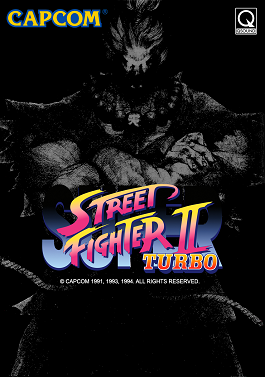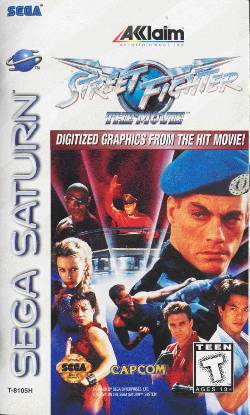
Street Fighter III: New Generation is a 1997 fighting game in Capcom's Street Fighter series, originally released as a coin-operated arcade game. The game, which was designed as a direct sequel to Street Fighter II (1991), initially discarded every previous character except for Ryu and Ken, introducing an all-new roster led by Alex. Likewise, a new antagonist named Gill took over M. Bison's role from the previous games as the new boss character.

Marvel vs. Capcom is a series of crossover fighting games developed and published by Capcom, featuring characters from their own video game franchises and comic book series published by Marvel Comics. The series originated as coin-operated arcade games, though later releases would be specifically developed for home consoles, handhelds, and personal computers.

Super Street Fighter II: The New Challengers is a 1993 competitive fighting game produced by Capcom and originally released as an arcade game. It is the fourth game in the Street Fighter II sub-series of Street Fighter games, following Street Fighter II: Hyper Fighting (1992). It refines and balances the existing character roster from the previous versions, and introduces four new characters, including Cammy and Dee Jay. It is the first game on Capcom's CP System II hardware, with more sophisticated graphics and audio over the original CP System hardware used in previous versions of Street Fighter II.

X-Men vs. Street Fighter is a crossover fighting video game developed and published by Capcom. It is Capcom's third fighting game to feature Marvel Comics characters, following X-Men: Children of the Atom and Marvel Super Heroes, and is the first installment in the Marvel vs. Capcom series. As the title suggests, the game includes characters from Marvel's X-Men franchise and the cast from Capcom's Street Fighter series. Originally released as a coin-operated arcade game in 1996, it was ported to the Sega Saturn in 1997 and the PlayStation in 1998. The original arcade version is included in the game lineup for Marvel vs. Capcom Fighting Collection: Arcade Classics, released for the Nintendo Switch, PlayStation 4 and Windows in 2024.

Marvel Super Heroes vs. Street Fighter is a 1997 crossover fighting video game developed and published by Capcom. It is the sequel to X-Men vs. Street Fighter (1996) and the second installment in the Marvel vs. Capcom series. After its release on arcades, it received ports to the Sega Saturn in 1998 and the PlayStation in 1999.

Super Street Fighter II Turbo, released in Japan as Super Street Fighter II X: Grand Master Challenge is a 1994 fighting game released for the arcades by Capcom. It is the fifth installment in the Street Fighter II sub-series of Street Fighter games, following Super Street Fighter II: The New Challengers (1993). Like its predecessor, it ran on the CP System II hardware.

Street Fighter Alpha 3, released as Street Fighter Zero 3 in Japan, Asia, South America, and Oceania, is a 2D fighting game originally released by Capcom for the arcade in 1998. It is the third and final installment in the Street Fighter Alpha sub-series, which serves as a sequel to Street Fighter Alpha 2, and ran on the same CP System II hardware as previous Alpha games. The game was produced after the Street Fighter III sub-series has started, being released after 2nd Impact, but before 3rd Strike. Alpha 3 further expanded the playable fighter roster from Street Fighter Alpha 2 and added new features such as selectable fighting styles called "isms".

X-Men: Children of the Atom is a 1994 fighting game developed and published by Capcom and released on the CP System II arcade hardware. It was released in December 1994 in Japan and in January 1995 in North America and Europe.

Super Puzzle Fighter II Turbo, released in Japan as Super Puzzle Fighter II X, is a tile-matching puzzle video game released in 1996 for the CP System II (CPS2) arcade board, by Capcom and its Capcom Coin-Op division. The game's title is a play on Super Street Fighter II Turbo, as there were no other Puzzle Fighter games at the time, and the game includes music and interface elements spoofing the Street Fighter Alpha and Darkstalkers games. It was a response to Sega's Puyo Puyo 2 that had been sweeping the Japanese arcade scene.

Street Fighter Alpha Anthology, released in Japan as Street Fighter Zero: Fighters' Generation, is a 2006 fighting game compilation that collects the Street Fighter Alpha series.

Street Fighter EX2 is a 2D head-to-head fighting game with 3D graphics co-produced by Capcom and Arika and originally released in 1998 as a coin-operated arcade game for the Sony ZN-2 hardware. It is the sequel to the original Street Fighter EX, and the second spin-off game of the Street Fighter series. An updated version of the game titled Street Fighter EX2 Plus was released in 1999 in arcades as well and subsequently ported to the PlayStation the same year. Its sequel, Street Fighter EX3, was released in 2000.

Street Fighter Collection is a 1997 fighting game compilation developed and published by Capcom for the Sega Saturn and PlayStation. It contains the original Super Street Fighter II: The New Challengers (1993), its follow-up Super Street Fighter II Turbo (1994), and an enhanced version of Street Fighter Alpha 2 titled Street Fighter Alpha 2 Gold, which is exclusive to this compilation.

Street Fighter IV is a 2008 arcade fighting game developed by Capcom and Dimps and published by Capcom. It was the first original main entry in the series since Street Fighter III in 1997, a hiatus of eleven years. Designed for the Taito Type X2 hardware, it was ported with additional features in 2009 to PlayStation 3, Xbox 360 and Windows, along with mobile versions later on.

Street Fighter Alpha: Warriors' Dreams, known as Street Fighter Zero in Japan, Asia, South America, and Oceania, is a 2D arcade fighting game by Capcom originally released in 1995 for the CP System II hardware. It was the first all new Street Fighter game produced by Capcom since the release of Street Fighter II in 1991. Plotwise, it serves as a prequel to Street Fighter II and thus features younger versions of established characters, as well as characters from the original Street Fighter and Final Fight.

Street Fighter is a Japanese media franchise centered on a series of fighting games developed and published by Capcom. The first game in the series was released in 1987, followed by six other main series games, various spin-offs and crossovers, and numerous appearances in other media. Its best-selling 1991 release Street Fighter II established many of the conventions of the one-on-one fighting genre.

Street Fighter: The Movie is a 2D head-to-head fighting game developed by Capcom, released for the PlayStation and Sega Saturn in 1995, with the game serving as a North American launch title for the PlayStation. The game is based on the 1994 live-action Street Fighter movie, itself based on the Street Fighter series of fighting games, and uses digitized images of the film's cast as the characters. While it shares its title with the arcade game Street Fighter: The Movie, the home version is not a port but a similar game developed on the same premise. The game was a commercial success, but received widespread negative reception.

Street Fighter: The Movie is a 1995 fighting game released as an arcade game. The game is based on the 1994 live-action Street Fighter film, itself based on the Street Fighter series of fighting games, and uses digitized images of the film's cast. The game was developed by Chicago-based Incredible Technologies and distributed to the arcades by Capcom. The game was widely panned by critics.

Capcom Fighting Jam, released in the US as Capcom Fighting Evolution, is a 2004 head-to-head fighting game from Capcom. It was originally released as a coin-operated arcade game for the Namco System 246 hardware and ported to the PlayStation 2 and Xbox. The game features characters from three different incarnations of the Street Fighter series, as well as characters from the Darkstalkers series and the CPS III arcade game Red Earth, with each character employing the fighting system from the game which they represent.

Super Gem Fighter Mini Mix, also released as Pocket Fighter, is a 1997 fighting video game produced by Capcom for the CPS II arcade system. The game uses the same super deformed character designs previously used in Super Puzzle Fighter II Turbo, a puzzle game by Capcom. It was ported in 1998 to the PlayStation, which retained the Pocket Fighter title for its North American and PAL releases, and then the Sega Saturn and WonderSwan, both in Japan only.



















